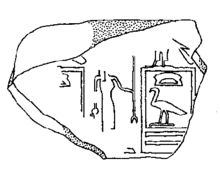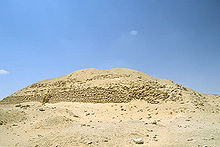Khaba
![]()
The title of this article is ambiguous. For other meanings, see Chaba (disambiguation).
Chaba (actually Hor-Chaba) is the Horus name of an ancient Egyptian ruler (pharaoh) who reigned during the 3rd Dynasty. Thomas Schneider dates his reign to the period around 2670 BC, whereas Michael Rice dates it to the period between 2640 BC and 2637 BC.
Chaba is archaeologically attested and documented thanks to clay seal impressions and vessel inscriptions, but questions have arisen about his person and reign that have led to divergent theories and views within research. Thus, Chaba seems to have been the first ruler of Egypt who had a gold horus name.
His chronological position within the dynasty and his exact duration of reign are disputed. The reason for this are contemporary seal inscriptions, which provide no clues to special political, cultural or religious events, but are limited solely to the stringing together of king's names and official titles. In addition, there are later king lists of the Ramesside period in which highly distorted cartouche names appear which contradict each other with regard to position and number of ruler names. These inaccuracies and lack of sources make it difficult to evaluate with any certainty the historical figure of Chaba and his reign. For this reason, various Egyptologists and historians have made and presented different attempts to equate Chaba's Horus names with cartouche names of Ramesside king lists.
It is also disputed where Chaba was buried. While the majority of Egyptologists favor a stepped pyramid in Saujet el-Arjan as the burial site, others suspect the nearby mastaba Z500 as the burial place.
Reign
The exact chronological position of Chaba's reign cannot be determined precisely, since the Ramesside king lists partly contradict each other concerning the number and position of certain king names. An evaluation of possible reigning events is also difficult.
Chronology and duration of rule
Nabil Swelim considers Chaba's reign at the beginning of the 3rd Dynasty. Background of this theory is the striking similarity between Chaba's Horus name and that of king Chasechemui, the last ruler of the 2nd dynasty. Both names begin with the hieroglyph N28 (sunrise symbol, reading Cha). Swelim sees himself reminded of the Horus names of kings Netjerichet and Sechemchet, both ending with the same symbol (hieroglyph F32, reading Chet). Sechemchet was according to the majority of Egyptologists the direct successor to the throne of Netjerichet. According to Swelim such coincidences in ruler names are a strong indication for a direct succession to the throne.
Michael Rice, on the other hand, regards Chaba as a ruler in his own right and sees him as the direct predecessor of King Huni.
Both theses are not uncontradicted. Grimal, Helck, Wilkinson and Stadelmann point to a typical design of vessels for the 3rd Dynasty in which only the Horus names of kings are inscribed on stone vessels. This type of design is - beside Chaba - also attested for the kings Netjerichet and Snofru. Under Snofru this fashion was partly still further practiced. Since stone vessels of Chaba only show his Horus name, this is regarded as a safe evidence for a dating of Chaba's reign into the 3rd Dynasty. In addition, there are the theories of equation of Chaba with Huni put forward by Stadelmann and Grimal. Therefore, the majority of Egyptologists considers the reign of Chaba to be at the end of the 3rd Dynasty.
A more exact determination of Chaba's reign is also problematic due to this circumstance. If Chaba should be identical with Hudjefa II from the Turin royal papyrus, his reign lasted six years; if, on the other hand, the equation with king Huni is correct, then he ruled for 24 years.
Events
The current archaeological find situation allows only few conclusions about possible events during the reign of Chaba. The evaluations are complicated by the fact that contemporary stone vessels of the 3rd Dynasty are uninscribed except for the mention of the name of Horus. This is documented for example for Horus names like Netjerichet, Chaba and Nebma'at. The only exception is a stone bowl from Abusir with the throne name of king Huni. Especially during the 3rd Dynasty the royal vessel decoration included only the Horus name of the reigning king, images of deity figures, building representations and names as well as mentions of cult festivals are completely missing. Stone vessels of the predecessor dynasties, on the other hand, are extensively inscribed and mention cultically as well as economically important events that took place under the named ruler.
The numerous clay seal impressions, especially from Elephantine, also hardly allow any conclusions, although they show more inscriptions than the mere representation of the king's name. The seal inscriptions mention the titles of high officials typical for this period as well as the places of origin of the vessel contents to which the clay seals once belonged. According to the inscriptions, most of the vessels came from Thinis. One particular official title that survives from the reign of Chaba is that of "Gaufürsten/Bürgermeister und Schatzmeister von Elephantine". The name of the official is not preserved. Other seals have remnants of figural representations of the goddess Bastet. From the ruins of a local temple of Horus at Hierakonpolis come clay seals with the remains of the representation of the god Asch. Ultimately, however, even the clay seal impressions hardly allow any conclusions to be drawn about the course of Chaba's reign, since until the late middle of the Old Kingdom it was customary for clay seal inscriptions to be limited to the stringing together of king's names, official titles, and figures of the gods in alternation.

Clay seal of the Chaba with mention of the title of mayor or gau prince.

Clay seal of Chaba with the badly destroyed representation of a deity.
Grave
→ Main article: Chaba pyramid
The burial place of King Chaba is believed to be a step pyramid at Saujet el-Arjan, located about 8 km southwest of Giza. The monument was excavated around 1839 by John Shae Perring and is today located within a restricted military area. The original height of the pyramid is estimated to be about 42 to 45 m with an edge length of about 84 m. Archaeologists and Egyptologists like Jean-Philippe Lauer assume that the building should have consisted of five steps. Today, only two steps remain and the total height is only about 17 m. The remaining stump is completely encased in rubble and loose bricks and is therefore called the "Rubble Hill Pyramid" by locals. Based on its present condition, it cannot be determined with certainty whether the monument was completed or remained unfinished. The attribution to King Chaba was so far only based on the fact that stone vessels and clay seal fragments with Chaba's Horus name were discovered in the nearby mastaba Z500 and that the mastaba most likely belongs to the tomb complex of the Shift Pyramid. However, the attribution of the pyramid to Chaba is not unchallenged.
Researchers such as Miroslav Verner argue that Chaba may not have been buried in the pyramid, but in Mastaba Z500. The background is the already mentioned circumstance that numerous artifacts with Chaba's name were discovered in this tomb. In the pyramid itself no burial objects have been found so far and the underground burial galleries are unmarked. The pyramid would therefore belong to another, still unknown ruler.

Ruin of the Chaba pyramid in Saujet el-Arjan.
Search within the encyclopedia